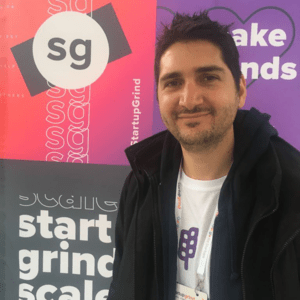I’m a computer engineer transformed into a ⚙️ passionate No Coder ⚙️. Reach out if you want to get introduced or learn more about the No Code world!
It’s not so complicated: Product market fit for startups
About this episode
Product Market Fit is a term that we meet quite often when dealing with startups.
And it’s quite confusing, as there are more than 4 different ways to define it.
In this episode, we are meeting Adi Joseph Shmorak, whose mission is to guide startups towards finding PMF.
What they talked about:
- How can PMF be defined and why is it important
- Common misconceptions around it
- the 4 steps of the PMF journey
- the mistake that many entrepreneurs make with their MVP
And all this in less than 15 min!
Transcript
Adi Joseph Shmorak: Hi, everyone, my name is Adi Shmorak, from Israel. I’m a product manager and Product Market Fit consultant. I help early stage startups find a way to product market fit through validation based on lean startup methodologies and proper product management.
Spyros Tsoukalas: Welcome, Adi. Such an exciting discussion for us today. So I really enjoy your expertise and have enjoyed some growth mentor sessions with you in the past. Would you like to introduce us to work product market fit means when talking about startups?
Adi Joseph Shmorak: And yes, of course, well, product market fit is a fairly common concept. It’s been around for quite a time quite a while. Basically, it means that you as a startup can solve a problem for a market that has this need, and the capability to also benefit you as a company. So you’re actually being able to create value where it’s needed. And you’re able to retain some of that value for yourself, usually in form of profit, or maybe data of users. So that is basically what it means.
Spyros Tsoukalas: How did you measure it, though?
Adi Joseph Shmorak: So there are a few ways to measure it. Usually it’s by proxy, or thumb rule. So if you’re a VC, then you would look for a $1 million ARR, as a proxy for Hey, this company has Product Market Fit has reached product market fit. But there are other indicators that can be indicative of reaching product market fit. One of them is retention if you have consistent retention. Another one is word of mouth organic growth, meaning if you’re able to recruit customers without spending dollars on marketing and acquisition, so you’re not forcing users coming to your platform, then that is also a good indication that you’re at least on your way to product market fit. It also varies if you’re a B2B or B2C model. So in B2C, you would like to see that organic growth in B2B, it’s a little bit harder to get organic growth nine. So you would like to look at a high net promoter score. And if you have a sales team doing sales, then when your sales team reaches a sales yield of one or more, meaning that your sales team is making at least the same money as they are costing you, then these are also good indications for product market fit. And other famous a indicator is what John Ellis describes as the PMF survey US basic basic question. You need a lot of users for that or a significant amount of users. But you just asked them how would you feel if you could no longer use the product. And there are a few options, very disappointed, somewhat disappointment, not disappointed at all or not applicable, not relevant, not using the products, I think that’s all and you want to have at least 40% of your users opting into that option that, hey, we will be very disappointed. So this is another indicator that you’re probably average product market fit or on your way to.
Spyros Tsoukalas: Great, I love how many examples you brought of how you can indicate that. So why do startups care about product market fit? I mean, why this concept? is this applicable to other activities like fundraising or other things that they do, or it’s just like, if you recall metric that they just care, because when you achieve that, like you said, in the first indicator, we are profitable, or something similar.
Adi Joseph Shmorak: So at least from my perspective, and some might argue, but I think the product market fit is the only thing that you should care about when you start your business or your startup. Because you want to make sure that whatever you’re building and later growing, it can actually grow and can actually fulfill a need. And that you can actually, like I said before we obtain some of the value for you, and your investors, VCs angels, they are also interested in that because they want to get a very good ROI. So they want to make sure that whatever you’re building, whatever you’re spending the dollars on is something worthwhile doing and that it addresses a big problem in a big market that gained a that you can retain some value for yourself. So product market fit at the beginning is the only thing that you should care about. And all the other metrics you should only care about if they help you get to product market fit. And for example, ARR is always sought after. But if you’re spending a lot of dollars on advertising, and that is where your ARR counts, but you have low retention and high churn, then don’t worry about the ARR worry about the churn worry about the retention, make sure to fix them and only then care about the ARR.
Spyros Tsoukalas: Make sense. And I really like moving the attention like from acquisition to retention and churn like these are very important things that people sometimes forget. So, are there any common misconceptions around product market fit, like things that people don’t understand or usually understanding in the wrong way.
Adi Joseph Shmorak: And there’s a, I don’t remember who said it, but it’s an angel investor, when he said something that was very concise. And to the point, he said that first time entrepreneurs focus on product rather than market. And I think that that is the biggest, most painful problem an entrepreneur can make, I have a great product. And I think it’s going to be very, very good. And I will build it and they will come. And they forget that there is a market to serve, and that they don’t have all the answers, and they start building before they have at least some of the answers. So the mistake is not starting with the market. The market, when I talk about product market fit, I say market is pain. Think about a pharmaceutical company that works on a new drug. Let’s say that it’s going to solve diabetes, they don’t care if it’s their market is not people ages 20 to 30, that go to the beach, and those personas are non existent. When you’re talking about product market fit, the only indicator or the only way to describe your market is people with diabetes. That’s it, that’s the market, you may focus on those with diabetes, that live in Israel or live in the US or in that age group, whatever you have access to whatever you have channeled to whatever, wherever the product is more effective. But you want to start with that man, if you want to start focusing on the problem that you’re solving. So market is the pain is the need. And that’s the way that you should look at it. And that is where you should start. So if you don’t start there, that’s a common misconception around product market fit. I think that another misconception maybe is, in terms of getting to raising funds, is how you can describe that you’re on your way to product market fit. And I see entrepreneurs trying to show their investors that they were very, very confident, but they don’t have the data to back it up. And that is something that I would highly recommend, if you’re not sure what direction you’re going, you have a couple of options in terms of who’s the market, what’s the value proposition, it’s okay to communicate it especially in C or precede stages, but include the validation and the experiments that you’re doing in order to validate which route to go. So it’s not always about showing conviction, or being very How should I say the very kind of, hey, I know what I’m talking about, this is where we should go, you can be a little bit more a concrete about where you’re heading. But be sure to say, Hey, these are the assumptions that we have. This is the validations that we’re running now, we’ll have results in a few weeks. Also a and share that with your investors or potential investors and even get their feedback on that. And you can also ask them, What would make you feel comfortable in choosing one direction or another. And they will tell maybe they’ll say, we want to see paying customers or we want to see at least one LOI or one analog presale reorders, they will share with you what they would need to drive conviction. So you don’t necessarily have to exhibit like high confidence in the direction that you’re going.
Spyros Tsoukalas: Okay, so given all these misconceptions and mistakes people do started to do and the thing you mentioned earlier, like the product market fit is what we should really care when building a business. When when a team is trying to reach this goal. How should they prioritize or frame their way of thinking around customers, their business model, the pricing, the product management that I know you like? I mean, these are all elements that come into play when a team is working? Like is there any particular way of thinking that could help us like understand how they should be thinking towards product market fit? Like maybe their priorities are their goals towards the ultimate goal?
Adi Joseph Shmorak: So I think that the way that I break down the journey to product market fit is through four steps. There are four kinds of milestones, let’s let’s call them checkpoints that you need to go through and you keep revisiting them because it’s an iterative process. But you start with the market that I already said you start with a pain, what’s the pain that I’m going to solve? I give an example of diabetes, and then you’re trying to see okay, what’s the value proposition? What’s the promise that I can give my potential customers that they’re going to say, Oh, this is interesting. Because if I have a problem, I’m already searching for a solution. So a lot of companies are offering me different value proposition. And you need to come with something very unique for me to say, oh, I want to check that product. And once I have that value proposition that captures my attention, the audience attention studies, and create some movement toward my way, then it can go into the next step. And that is the product itself of the product, which is I mentioned in the misconceptions. Entrepreneurs, be thinking to start with a product, it’s the third step, find out what’s the problem, what promise you can make, so they will come to you, and then the product needs to deliver on that promise. And lastly, is the business model, which means, okay, I have this product, I want to monetize it, how can I capture value back, so product is creating value for the customer, but the business model is driving it back. So sometimes business model comes a little bit earlier. But the way that the team should frame their thinking is okay, we have to figure these four reasons, one is connected to the other, we need to start with the market, then the value proposition, then the product, then the business model. And we have to have assumptions, not ideas, or suggestions or directions, you need to have assumptions, and you have to validate them. And you can validate 100%, you just go with what feels what shows better attraction. So maybe you get more reactions to one value proposition than the other, maybe one market shows more interested in what you have to offer than the other. And based on that you can kind of it’s like walking in a foggy forest, you have kind of, you don’t see where early very well and your arms are reached out front, and you’re trying to kind of feel your way around. And every time you hit a trees, hey, I had an assumption that there was a tree going to be there. And now I found that there is a tree now I’m going to change my course a little bit. So in terms of the mindset and the processes, walk with assumptions, try to validate them as best you can. And beware of confirmation bias, the confirmation bias will let you or make you think that whatever you’re thinking is right and the wrong the right goals always. And that’s not the case, usually you’re not on the right course. So we will have confirmation bias. And I think that these are the main themes in terms of the mindset that you need to have when searching for product market fit because this is a search. It’s not an epiphany that comes to you. And I know what I need to build and I know how people will cannot prove it.
Spyros Tsoukalas: I am amazed by the way you summarize all these value in like a few minutes. So there are two bonus questions that I have for you. One is what is your favorite tool lately? And the other one is what is your favorite book? If any, like regardless of topic, it doesn’t have to be a business one.
Adi Joseph Shmorak: Okay, so my latest tool is reflect.app. It’s a notetaking backlinking kind of tool, it’s becoming very common that you create nodes that can backlink to one another. So you create like, it automatically creates like a mind map for you when everything is connected. So I have a conversation with you on product market fit. These are two backlinks, your own one backlink and I can see all the history that we have together and PMF is another backlink. And I can see all the history that I have on PMF. And it can go and diverge and converge from those two notes. So it’s very easy to find a way around. So I started using it like a month ago, and I really, really like it. So that’s a tool that I’m enjoying. As for a book, there’s a book by Michael Singer called The Surrender Experiment. Michael Singer is a is an entrepreneur. He was one of the first to start doing software development for the medical industry. And he was I think it was like the first program to walk in his flip flops from a remote house like a cabin in the woods in Florida. And he’s been doing this like for 30 or 40 years. He did an IPO and all those kinds of things. But he’s a very humble and new and interesting person. All the time was interested in yoga and meditation and mindfulness and I’m talking 50 years ago, 40 years ago. And the surrender experiment disease life story from a perspective of just going with the flow and going into whatever the world presents itself to us are really connected with this concept. And the book is very, very interesting for entrepreneurs and others. So, The Surrender Experiment by Michael Singer.
Spyros Tsoukalas: Adi, thank you very much for taking the time to share all your know how experiences and expertise with us today. And I hope that everyone is going to enjoy this discussion as much as I did.
Adi Joseph Shmorak: With pleasure, I’ll give you a bonus answer, even though you’re not asking, because you asked the misconceptions. And there is another one that I would very much like to warn entrepreneurs off. There’s the concept of MVP, like minimum viable product. And people have a big misconception about the MVP, they think it’s a, it’s a scaled down version of the product or not so well developed or designed a version of the product. It’s not an MVP is just another test. An MVP can be a spreadsheet, an MVP can be a chatbot, an MVP, can you doing all the work behind the scenes like a Mechanical Turk. So don’t think of an MVP as a scaled down version of your product, think of an MVP as the quickest way in which you can provide some value to your ideal customers. And if it’s manual, that’s fine. It doesn’t have to be scalable. It’s just the validation tool to make sure that the audience that you’re targeting really needs the value that you’re offering. And that you can really, that you really understand what they need. And you can actually provide that value to them. So that’s the job and MVP has. So don’t build a product. Or don’t think the MVP is just another product. It’s not it’s another experiment.
Spyros Tsoukalas: That is something that I have experience with. And thank you for clarifying that. Although I didn’t ask directly. Thank you. This is a great warning for fellows that might help them avoid the mistakes that probably you and I have made in the past.
Adi Joseph Shmorak: I think that there are a lot of entrepreneurs that if they’re listening, and they’ve been around, they nod their head and yeah, that was my mistake as well. So we’ve all made those mistakes. And I think the best we can do is just one the outdoors. Hopefully they want to repeat those same mistakes.
Spyros Tsoukalas: That’s what GrowthMentor is all about.
Adi Joseph Shmorak: I couldn’t agree more.
Spyros Tsoukalas: Thank you very much for this lovely evening Adi and looking forward for more interesting discussions like this one.
Adi Joseph Shmorak: Thank you. Thank you for the opportunity. Thank you for everyone listening.
In this episode


The road to Product/Market Fit can be an incredible journey of discovery and growth. But it’s not always like this. I work with early-stage startups, guiding them on the journey, saving time, money, and heartache. Join me.
Join the community
Enjoy the peace of mind that advice is always only one Zoom call away.


